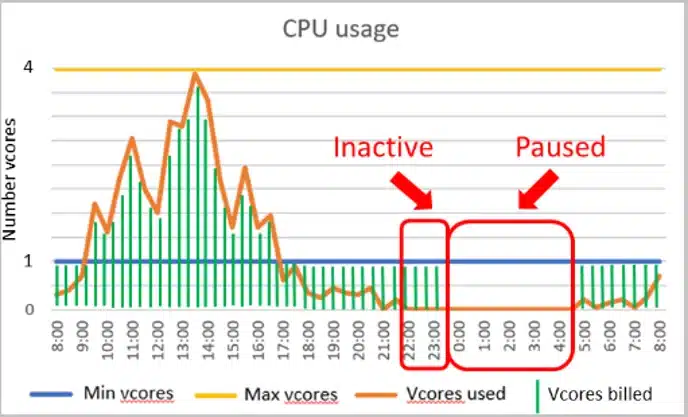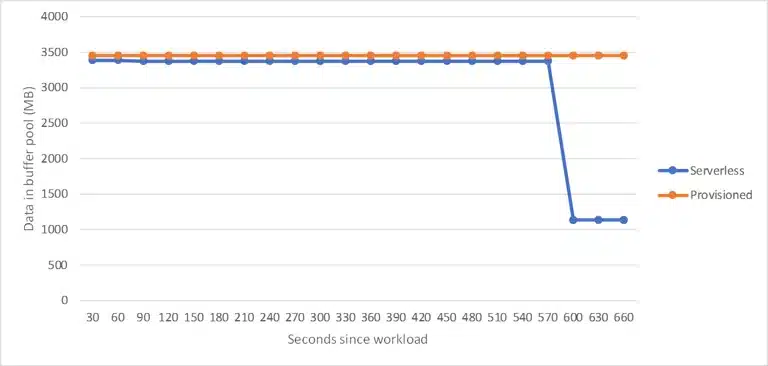(Spoiler alert, you can’t :) )
But first things first, what the heck is serverless? Azure SQL Database serverless is a new compute tier made for single databases. This new model automatically scales the compute based on the actual workload per second. This means that you only have to pay for the compute resources (memory & vCores) you use. Furthermore, serverless has an autopause function. It will pause your database when it remains inactive for a period of minimum 1 hour. For a paused database, only the storage is charged.
Only paying what you use, it does seem tempting doesn’t it? Still, there are reasons why provisioned tiers might be a better fit for your workload. First of all, as per writing only general purpose is supported in the serverless compute tier. If you are using business critical and your workload needs the improved I/O performance then serverless probably won’t be a good fit for you. Secondly, you only receive 3GB of memory per vCore whereas you receive 5,5 or 7GB per vCore in the provisioned tiers, depending on the generation of CPU you choose. Besides, you can maximally assign 16 vCores to serverless.
It’s also possible that you experience some delay in the ramp-up of the compute power after idle periods. In extreme circumstances, it’s even possible that the underlying host cannot provision enough resources within a few minutes. In that case “load balancing” will automatically occur. During load balancing the database remains online except for a brief period at the end of the process when all connections are dropped. This behavior is comparable with resizing a database in any provisioned tier.
Lastly, after an auto-pause the first connection to the database will fail.
Although the beforementioned points are all valid, it isn’t what would stop me from using serverless. The first possible obstruction lies in the way that SQL Server manages its memory. As we’ve all learned when installing an on premise SQL Server instance, you should specify the memory boundaries and let the SQL OS manage its own memory. Traditionally SQL Server isn’t very keen on releasing memory to the OS. When using serverless databases on the other hand, memory is reclaimed from the database more frequently. This process is triggered whenever cache and CPU utilization is low. Memory entries to free up are chosen the same way as for provisioned databases when memory pressure is high.
This can result in increased disk I/O and query plan compilations after a period of low usage. The total cache size will never go below its minimum size. This boundary is defined by the configured vCore range. It’s important to realize that despite the impact on performance, this behavior certainly has its merits. The sooner memory is released, the less there will be charged.
To test this mechanism I started an identical workload on a serverless and on a provisioned database. The serverless database was configured to use between 0,5 and 1 vCore. Afterwards I monitored the size of the buffer pool. As you can see, after approximately 10 minutes the serverless’ buffer pool was reduced to 1GB. The buffer pool of the provisioned database remained stable, no datapages were flushed from cache.

https://docs.microsoft.com/en-gb/azure 1
The main goal of using serverless instead of provisioned database is to reduce cost. It’s very important to gain knowledge about your workload before switching to serverless. The storage cost is the same as for provisioned databases. The compute cost on the other hand is calculated based on the vCores and memory used:

At first sight it would seem that, unless your database is constantly using all available resources, serverless would always be the cheapest option. There is a catch though… Serverless compute resources are twice the price of provisioned compute resources. In other words, a constant high load would cost more in serverless than it would in provisioned. The use cases you are looking for are single databases with an intermittent and unpredictable load followed by periods of lower utilization or inactivity. Typical examples are databases used for dev environments.
Although the serverless compute tier isn’t a fit for each database, it certainly has its use cases. I’ve used it a couple of times and it can save you a serious amount of money. Just keep in mind that there might be a negative impact on performance and that you must first examine your workload before choosing for serverless.
| Cookie | Duration | Description |
|---|---|---|
| ARRAffinity | session | ARRAffinity cookie is set by Azure app service, and allows the service to choose the right instance established by a user to deliver subsequent requests made by that user. |
| ARRAffinitySameSite | session | This cookie is set by Windows Azure cloud, and is used for load balancing to make sure the visitor page requests are routed to the same server in any browsing session. |
| cookielawinfo-checkbox-advertisement | 1 year | Set by the GDPR Cookie Consent plugin, this cookie records the user consent for the cookies in the "Advertisement" category. |
| cookielawinfo-checkbox-analytics | 11 months | This cookie is set by GDPR Cookie Consent plugin. The cookie is used to store the user consent for the cookies in the category "Analytics". |
| cookielawinfo-checkbox-functional | 11 months | The cookie is set by GDPR cookie consent to record the user consent for the cookies in the category "Functional". |
| cookielawinfo-checkbox-necessary | 11 months | This cookie is set by GDPR Cookie Consent plugin. The cookies is used to store the user consent for the cookies in the category "Necessary". |
| cookielawinfo-checkbox-others | 11 months | This cookie is set by GDPR Cookie Consent plugin. The cookie is used to store the user consent for the cookies in the category "Other. |
| cookielawinfo-checkbox-performance | 11 months | This cookie is set by GDPR Cookie Consent plugin. The cookie is used to store the user consent for the cookies in the category "Performance". |
| CookieLawInfoConsent | 1 year | CookieYes sets this cookie to record the default button state of the corresponding category and the status of CCPA. It works only in coordination with the primary cookie. |
| elementor | never | The website's WordPress theme uses this cookie. It allows the website owner to implement or change the website's content in real-time. |
| viewed_cookie_policy | 11 months | The cookie is set by the GDPR Cookie Consent plugin and is used to store whether or not user has consented to the use of cookies. It does not store any personal data. |
| Cookie | Duration | Description |
|---|---|---|
| __cf_bm | 30 minutes | Cloudflare set the cookie to support Cloudflare Bot Management. |
| pll_language | 1 year | Polylang sets this cookie to remember the language the user selects when returning to the website and get the language information when unavailable in another way. |
| Cookie | Duration | Description |
|---|---|---|
| _ga | 1 year 1 month 4 days | Google Analytics sets this cookie to calculate visitor, session and campaign data and track site usage for the site's analytics report. The cookie stores information anonymously and assigns a randomly generated number to recognise unique visitors. |
| _ga_* | 1 year 1 month 4 days | Google Analytics sets this cookie to store and count page views. |
| _gat_gtag_UA_* | 1 minute | Google Analytics sets this cookie to store a unique user ID. |
| _gid | 1 day | Google Analytics sets this cookie to store information on how visitors use a website while also creating an analytics report of the website's performance. Some of the collected data includes the number of visitors, their source, and the pages they visit anonymously. |
| ai_session | 30 minutes | This is a unique anonymous session identifier cookie set by Microsoft Application Insights software to gather statistical usage and telemetry data for apps built on the Azure cloud platform. |
| CONSENT | 2 years | YouTube sets this cookie via embedded YouTube videos and registers anonymous statistical data. |
| vuid | 1 year 1 month 4 days | Vimeo installs this cookie to collect tracking information by setting a unique ID to embed videos on the website. |
| Cookie | Duration | Description |
|---|---|---|
| ai_user | 1 year | Microsoft Azure sets this cookie as a unique user identifier cookie, enabling counting of the number of users accessing the application over time. |
| VISITOR_INFO1_LIVE | 5 months 27 days | YouTube sets this cookie to measure bandwidth, determining whether the user gets the new or old player interface. |
| YSC | session | Youtube sets this cookie to track the views of embedded videos on Youtube pages. |
| yt-remote-connected-devices | never | YouTube sets this cookie to store the user's video preferences using embedded YouTube videos. |
| yt-remote-device-id | never | YouTube sets this cookie to store the user's video preferences using embedded YouTube videos. |
| yt.innertube::nextId | never | YouTube sets this cookie to register a unique ID to store data on what videos from YouTube the user has seen. |
| yt.innertube::requests | never | YouTube sets this cookie to register a unique ID to store data on what videos from YouTube the user has seen. |
| Cookie | Duration | Description |
|---|---|---|
| WFESessionId | session | No description available. |